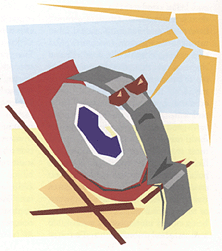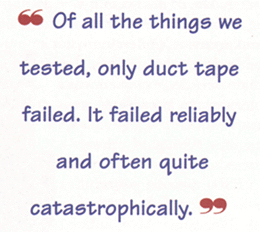
|
The news streaked across the nation and the world, was trumpeted in major newspapers and television networks in the U.S., Europe and Japan, and even made it onto PBS's "Car Talk": you can do a lot of things with duct tape, but you can't seal ducts.
At least not for long, according to Max Sherman and Iain Walker of the Lab's Environmental Energy Technologies Division (EETD). For three months last year they tested a variety of sealing materials-many kinds of duct tape, clear plastic tape, foil-backed tape, mastic, and injected aerosol sealant-under conditions similar to those encountered in real heating, ventilating and air-conditioning (HVAC) systems.
"Of all the things we tested, only duct tape failed. It failed reliably and often quite catastrophically," says Sherman, who heads EETD's Energy Performance of Buildings Group.
To test longevity, Sherman and Walker devised an accelerated aging test to mimick the cycling of a home or office-building HVAC system from night to day and winter to summer. Eight identical standard duct joints were sealed with different products. Hot air was forced through four of the ducts, cold air through the other four, and the hot and cold air flows were alternated every five minutes.
They also performed a bake test. In many parts of the U.S., Walker notes, air conditioning units and duct systems are often placed in the attic, "just about the worst place to put them. Attic temperatures can easily get up to 150 degrees F."
Of the 19 different sealant samples tested, duct tapes-the majority of the products tested-were the only sealants that failed. Eleven failed within days; some fell right off the joint. Clear tapes, foil-backed tapes, mastics, and the aerosol sealant system developed at Berkeley Lab formed good seals for the duration.
Duct tape was never intended for ducts. During World War II, the army bought quantities of the cloth-backed, rubber-adhesive tape for making emergency repairs on the battlefield. Contractors are not supposed to use it for structural purposes such as suspending ducts, however-a legal stricture that may be more often honored in the breach.
Walker notes that "tape manufacturers sell all kinds of colors and grades-'contractor' grade, 'professional' grade, even 'nuclear' grade, whatever that means. But performance doesn't seem related to grade." The Underwriters Laboratory (UL) has developed ratings for duct tape, but these refer to such characteristics as strength and fire resistance, not longevity. In fact, there is no UL rating that addresses the longevity of any duct sealant.
Sherman and Walker are working to have longevity standards adopted by such agencies as the California Energy Commission and the American Society for Testing Materials. Meanwhile the researchers are proposing more rigorous tests and new and improved sealants.
Walker says, "There is no reason to believe that duct tape adhesives and construction methods cannot be reformulated to work better at higher temperatures." There are products on the market that pass industry standards and also have good sealant longevity, but given its other advantages, Sherman and Walker would like to see better quality duct tape, as well as an improved rating system. end
|

